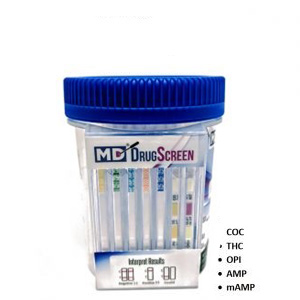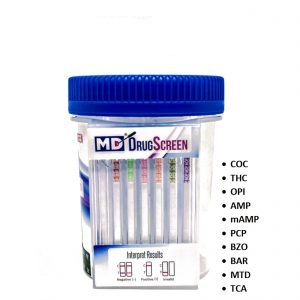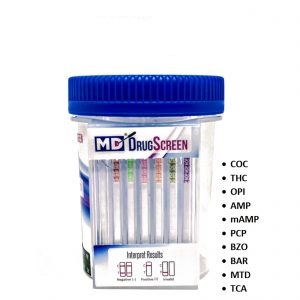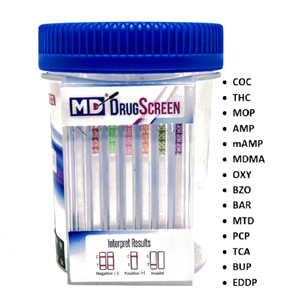
In-Home Drug Testing Union, UT
Instant Results - Accurate- Convenient
Accredited Drug Testing offers self-administered/self-collection drug testing products in Union, UT for employers that need On The Job Testing, In-Home Personal Use or for Family Testing Purposes. Our in-home/self-administered rapid drug testing options are a cost-effective alternative when needing to test an employee, individual, or family member when visiting a testing center is not convenient and you are in need of a reliable rapid baseline result. Call us today to order your instant testing devices or simply place your order below. All instant testing devices are FDA approved. The initial screen is used as an initial screening and it is recommended that all positive results should be confirmed by a certified laboratory. All Negative results are conclusive.
Instant Test Products

5 Panel Rapid Result
Our 5 panel rapid results is the most common urine drug test utilized for baseline testing. This drug test screens for the most commonly abused "street" drugs and is the most common utilized by employers and individuals.
5 Panel Instant Cup Screens For:
- Amphetamines (Methamphetamines is included)
- Cocaine
- Marijuana
- Opiates
- Codeine
- Morphine
- Heroin
- Phencyclidine (PCP)
Urine Cut-Off Levels
AMP 1000ng/mL, COC 300 ng/mL, OPI 2000 ng/mL, PCP 25 ng/mL, THC 50ng/mL

10 Panel Rapid Result
The 10-panel rapid results drug testing cup is a rapid test for the detection of the commonly abused "street" drug and prescription medication. The 10 panel is utilized by employers and individuals when they are in need of a more comprehensive result than the 5-panel drug test.
10 panel Instant Cup Screens For:
- Amphetamines (Methamphetamines is included)
- Cocaine
- Marijuana
- Opiates
- Codeine
- Morphine
- Heroin
- Phencyclidine (PCP)
- Benzodiazepines
- Barbiturates
- Methadone
- Tricyclic Antidepressants (TCA)
Urine Cut-Off Levels
AMP 1000ng/mL, BAR 300 ng/mL, BZO 300 ng/mL, COC 300 ng/mL, mAMP 1000 ng/mL, MTD 500 ng/mL, OPI 2000 ng/mL, PCP 25 ng/mL, TCA 1000ng/mL, THC 50ng/mL

12 Panel Rapid Result
The 12-panel rapid results drug test screens for the presence of 12 different metabolites to provide simple, fast and accurate results. This test is often used for comprehensive testing that must include additional drugs not screened for in the 10-panel rapid test.
12 Panel Instant Cup Screens For:
- Amphetamines (Methamphetamines is included)
- Cocaine
- Marijuana
- Opiates
- Codeine
- Morphine
- Heroin
- Phencyclidine (PCP)
- Benzodiazepines
- Barbiturates
- Methadone
- MDMA
- Oxycodone
- Methadone
- Buprenorphine-Suboxone
Urine Cut-Off Levels
AMP 1000ng/mL, BAR 300 ng/mL, BUP 5 ng/mL, BZO 300 ng/mL, COC 300 ng/mL, mAMP 1000 ng/mL, MDMA 500 ng/mL, MOP 300ng/mL, MTD 500 ng/mL, OXY 100 ng/mL, PCP 25 ng/mL, THC 50ng/mL

14 Panel Rapid Result
The 14-panel rapid results drug test is currently the most comprehensive instant drug test available. This rapid test will provide you with a broad range of drug metabolites to ensure the most comprehensive in-home drug test result.
14 Panel Instant Cup Screens For:
- Amphetamines (Methamphetamines is included)
- Cocaine
- Marijuana
- Opiates
- Codeine
- Morphine
- Heroin
- Phencyclidine (PCP)
- Benzodiazepines
- Barbiturates
- Methadone
- MDMA
- Oxycodone
- Methadone
- Buprenorphine-Suboxone
- Tricyclic Anti-Depressants,
- EDDP
Urine Cut-Off Levels
AMP 1000ng/mL, BAR 300 ng/mL, BUP 5 ng/mL, BZO 300 ng/mL, COC 300 ng/mL, EDDP, mAMP 1000 ng/mL, MDMA 500 ng/mL, MOP 300ng/mL, MTD 500 ng/mL, OXY 100 ng/mL, PCP 25 ng/mL, TCA 1000ng/mL, THC 50ng/mL
Additional Screening Options

Marijuana Only (THC) Instant
This single dip rapid result test screens for the presence of THC metabolites. Simple 2 step process (dip and read), results within 5 minutes or less.
Urine Cut-Off Levels
50 ng/mL cutoff level

Nicotine (Cotinine) Instant
This single use dip rapid result test screens for the presence of nicotine and cotinine metabolites in urine. Simple 2 step process (dip and read), results within 5 minutes or less.
Urine Cut-Off Levels
Cotinine 200ng/ml cutoff level

ETG Alcohol Instant
This single use dip rapid result test screens for the presence of alcohol metabolite (ETG) for up to 80 hours of consumption. Simple 2 step process (dip and read), results within 5 minutes or less.
Urine Cut-Off Levels
500 ng/mL cut-off level
Don't see your single drug test? Accredited Drug Testing also offers the following single panel drug test screening options for:
- Cocaine (COC)
- Marijuana (THC)
- Amphetamine (AMP)
- Methamphetamine (mAMP)
- Opiates (OPI)
- Oxycodone (OXY)
- Benzodiazepines (BZO)
- Barbiturates (BAR)
- Buprenorphine (BUP)
- Phencyclidine (PCP)
- MDMA-Ecstasy
- Methadone (MTD)
- Tramadol (TRM)
- Fentanyl (FEN)*
- K2 Spice (Synthetic Marijuana)*
If you are in need of a laboratory-analyzed drug or alcohol test, please find listed below our Union, UT testing locations.
7001 S 900 E STE 210 0.4 miles
MIDVALE, UT 84047
76 E 6790 S 1.0 miles
MIDVALE, UT 84047
234 E WINCHESTER ST 1.1 miles
MURRAY, UT 84107
7309 S 180 W 1.3 miles
MIDVALE, UT 84047
7998 S 1300 E 1.4 miles
SANDY, UT 84094
8074 S 1300 E 1.5 miles
SANDY, UT 84094
5911 S FASHION BLVD 1.6 miles
MURRAY, UT 84107
201 E 5900 S Ste 100 1.7 miles
MURRAY, UT 84107
1950 FORT UNION BLVD 1.9 miles
SALT LAKE CITY, UT 84121
925 EXECUTIVE PARK DR STE C 2.4 miles
SALT LAKE CITY, UT 84117
Handy Resources
Comprehensive Online Resources for Drug Testing
- National Institute on Drug Abuse (NIDA)
Provides comprehensive information on drug testing and its role in substance use disorder treatment.
- FDA: Drug Testing
Explains the FDA's role and regulations concerning drug testing for consumers.
- PDR.net
Provides detailed drug information and safety updates through a mobile-friendly platform.
- BeSafeRx - FDA
Resource by the FDA to help consumers identify and choose safe online pharmacies.
- SAMHSA: Drug Testing Resources for the Workplace
Resources and guidelines for drug testing in the workplace.
- Drugs.com
Provides drug information, side effects, and interactions for consumers and professionals.
- Drug Abuse Screening Test (DAST)
Online version of the DAST to help individuals assess whether they have a drug problem.
- Merck Manuals
Consumer-friendly medical resource providing comprehensive information on a wide array of health topics, including drug testing.
- SAMHSA Store
Provides access to resources and publications on substance use prevention and treatment.
- National Association of Boards of Pharmacy (NABP)
Information on state boards of pharmacy and regulations, including those related to drug testing.
- CDC: Workplace Health Promotion
CDC's resources on substance use and drug testing in the workplace.
- Mayo Clinic: Drug Testing
General information about the procedures and types of drug tests.
- MedlinePlus: Drug Testing
Offers information about various drug tests and their uses in medical diagnosis and treatment.
- University of Rochester Medical Center Health Encyclopedia
Provides a detailed entry on drug testing, including how tests are conducted and what they detect.
- World Health Organization (WHO)
International guidelines and information on public health, including substance abuse and drug testing.
- Healthline: Drug Testing
Consumer health site offering information on how drug tests work and what they look for.
- WebMD: Drug Testing
Provides a patient-oriented overview of drug testing and its purposes.
- National Center for Biotechnology Information (NCBI)
Provides a vast database of scientific studies, including research on drug testing and its effectiveness.
AI Overview
In-Home Drug Testing
In-home drug testing is a method used by individuals to check for the presence of drugs in the body, typically through urine, saliva, or hair sample tests. This form of testing is commonly employed by parents, employers, and educational institutions who wish to monitor drug use. It can also be useful for individuals monitoring their own recovery from drug addiction or for those who need to ensure a drug-free status for workplace compliance.
Types of In-Home Drug Tests
- Urine Tests: The most common type, these tests detect drugs and their metabolites in urine. They are known for their ease of use, rapid results, and affordability.
- Saliva Tests: These involve collecting saliva to detect drug residues. While not as sensitive as urine tests, they are less invasive and can detect drug use within a shorter window after consumption.
- Hair Follicle Tests: These tests provide a longer detection window, tracing drug use back up to 90 days. However, they are more expensive and require sending a sample to a lab for analysis.
Advantages of In-Home Drug Testing
In-home drug testing kits offer several benefits:
- Privacy: Allows testing in a private setting, which can be less stressful for individuals being tested.
- Convenience: Tests can be performed at any time and do not require appointments with healthcare providers.
- Immediate Results: Most tests provide results within minutes, offering quick insight into drug use.
- Cost-Effective: These tests are generally more affordable than testing conducted at medical facilities.
Limitations and Considerations
While in-home drug testing kits are useful, they also have limitations:
- Accuracy: The accuracy can vary between brands and types of tests. False positives and false negatives can occur, especially if the test kits are not used correctly.
- Legal Implications: The results from in-home tests might not be admissible in court or in formal employment settings, which often require confirmation from professional labs.
- Drug Detection Windows: Each drug has a different detection window, and some drugs may not be detectable shortly after use.
Choosing the Right Test
When selecting an in-home drug testing kit, consider the following:
- Substances Tested: Ensure the kit can detect the specific drugs you are concerned about.
- Sensitivity and Specificity: Look for kits that balance sensitivity (ability to detect drugs at low levels) with specificity (ability to avoid false positives).
- User Reviews: Research reviews and feedback to gauge the effectiveness and reliability of different brands and types.
In summary, in-home drug testing can be a valuable tool for maintaining a safe and drug-free environment. However, it is essential to understand its limitations and ensure proper usage to obtain reliable results.
Were you looking, instead, for:
Fort Union, historically Union, is a major commercial area and an early settlement in the Salt Lake Valley of Utah that is now split between the municipalities of Midvale, Cottonwood Heights, and Sandy. The fort after which the area was named was built early (1853) in the Salt Lake Valley's post-1847 history at a strategic point where escarpments on either side of the Little Cottonwood Creek valley create a narrow gateway to the upper valley and Little Cottonwood Canyon beyond. The effects of geography on travel through the area have also contributed to the area's much more recent success as a retail and employment destination.
The community of Union was first settled in 1849 by Jehu Cox. There were 8 families in the settlement that year. Silas Richards was appointed Bishop and organized a ward. By the following year the little settlement doubled in number. 1850 Silas Richards taught the first school of 30 to 35 scholars and he continued to do so for several winters. Union was first called Little Cottonwood, then South Cottonwood. The defensive Union Fort was founded to help secure the area for the early farmers living nearby, and it also provided security for shipments of granite (or quartz monzonite) from the mouth of Little Cottonwood Canyon for the construction of the Salt Lake Temple. 1853, in consequence of Indian depredations and trouble, it was thought to be expedient to build a fortification and live inside the walls. The elected site for the village was four rods square. The wall which had port holes was built of rock, clay and adobe twelve feet high around the sides. Twenty-three families lived inside in an adobe house. "We called our town Union." It was laid off in lots and streets. The cost was great. A large adobe school house was built in the center of Union to be used for school and meetings. Around noon July 24th, 1857 news was reported that troops were coming from the states, sent by the general government. "It was the first tidings of war." The week of November 16th 1857, Twenty [men] from Union (joined about 1500 in the mountains) to, "check the advance of our enemies who were threatening to exterminate us from the earth." February 1858 a great portion of the inhabitants of Union were plagued with a violent cough and cold, or influenza. Reportedly the disease prevailed in Salt Lake City and throughout the country. March 22nd 1858 orders were given to move South because of the advancing army. By May 27th an encampment of some 40 families from Union formed four miles south of Payson (about 43 miles south of Union). By July an agreement of peace had been entered into and families returned to Union. The fort was located near the modern intersection of North Union Avenue and 1000 East Street. The most visible remnants of this era are the old preserved Jehu Cox house (moved from its original location and now used as a shop), about a block north of North Union Avenue in an area that is now a large parking lot, and a historic marker at the site of the fort. The pioneer cemetery for the settlement is also preserved, but it is about a half mile southeast along Creek Road. Until the late 20th century, the Union Fort area remained a local center, but never had a large population and remained nearly rural. The name eventually was altered to "Fort Union".
The three most important roads in Fort Union are Utah State Route 71, 1300 East Street, and Fort Union Boulevard. For most of their length (they both run nearly the full length of the Salt Lake Valley), State Route 71 and 1300 East are parallel north-south roads running more than half a mile apart. In Fort Union, however, they swing closer together: 1300 East swings west to follow the ridge line of the escarpment south of Little Cottonwood Creek and State Route 71 swings east (from 700 East to 900 East) following the East Jordan Canal's curve into the lowlands around Little Cottonwood Creek. Fort Union Boulevard is an east-west road that curves around the northern Fort Union area on its way from Interstate 15 to Big Cottonwood Canyon.
Other roads around Fort Union include 1000 East Street, Creek Road, Union Park Avenue, and (nearby) Interstate 215. 1000 East runs due south between State Route 71 and 1300 East, Creek Road is the historically important route along the bottom of the Little Cottonwood Creek Valley, and Union Park Avenue was built to connect Fort Union to its exit on I-215 (about a third of a mile north of Fort Union Boulevard). Unlike most of the Salt Lake Valley, which uses a loose grid system, the roads entering the Fort Union are essentially radial; clockwise, starting from the north, the locally-radial roads are: Union Park Avenue, 1300 East, Creek Road, 1300 East, 1000 East, State Route 71, Fort Union Boulevard, and State Route 71.


